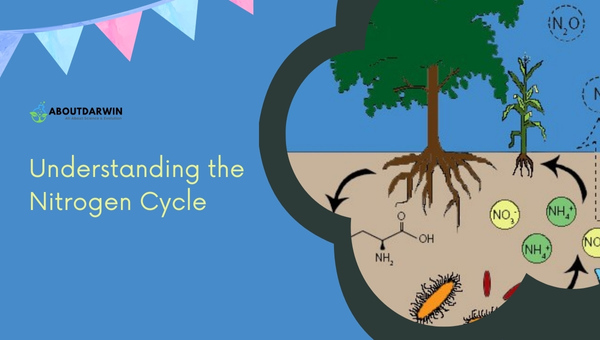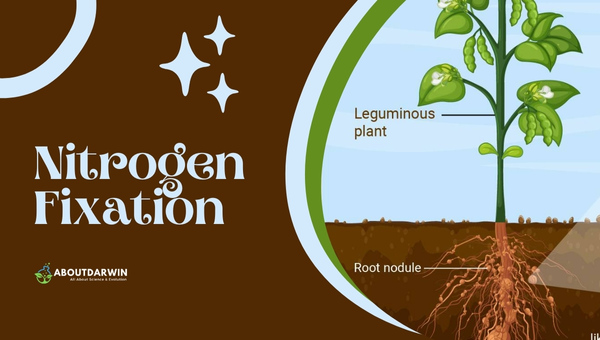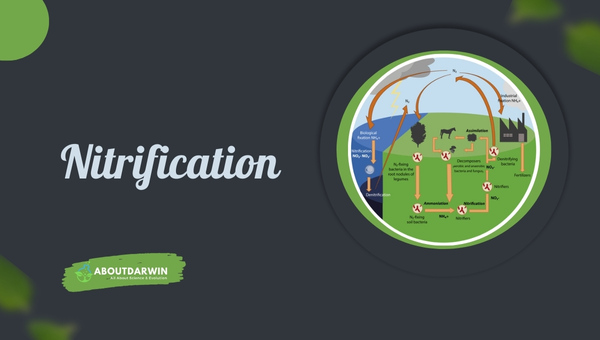Physical Address
304 North Cardinal St.
Dorchester Center, MA 02124
If you’re curious about how the environment processes nitrogen, look no further than the nitrogen cycle. This essential process plays a significant role in the ecosystem, helping plants and animals utilize nitrogen for various functions. In this article, I’ll be diving into the four steps of the nitrogen cycle and highlighting how they contribute to maintaining a healthy and balanced ecosystem.
First, it’s important to understand why the nitrogen cycle matters. Nitrogen is a crucial element for life, as it’s a key building block of proteins and DNA. Although nitrogen makes up 78% of the Earth’s atmosphere, it’s mostly in a form called N₂, which most plants and animals cannot use directly. That’s where the nitrogen cycle comes into play, converting atmospheric nitrogen into more accessible forms.
Let’s now explore the four steps of the nitrogen cycle: nitrogen fixation, nitrification, assimilation, and denitrification. Each step plays an essential role in converting nitrogen into more usable forms while also ensuring its continuous circulation within the environment. Stay tuned as I break down these four steps, and you’ll gain a deeper understanding of this fascinating natural process.
Contents
The nitrogen cycle is an essential process that plays a significant role in our ecosystem. Understanding the nitrogen cycle is crucial because it helps us better appreciate the delicate balance in nature and affects everything from the air we breathe to the plants and animals that make up our food supply.

The four main nitrogen cycle steps make it easier for you to grasp how this essential process works.
Understanding the nitrogen cycle is crucial for those interested in agriculture, climate change, and the balance of our ecosystems. Nitrogen fixation is the first of four essential steps to this complex process.

Nitrogen fixation is the process where atmospheric nitrogen (N2) gets converted into ammonia (NH3) or other nitrogenous compounds, which are then available for plant and microbe uptake. Nitrogen is crucial for life, as it’s an essential component of amino acids, proteins, and nucleic acids. Some important aspects of nitrogen fixation are biological fixation and lightning:
Atmospheric nitrogen, unfortunately, isn’t readily available for plant use due to its stable molecular structure. Nitrogen fixation bridges this gap, providing new sources of nitrogen that are available in the ecosystem.
However, remember that biological nitrogen fixation is far more efficient and abundant than contributions from lightning or industrial processes, accounting for about 50 to 90% of fixed nitrogen in non-fertilized ecosystems [^1^].
While understanding nitrogen fixation is essential to the overall nitrogen cycle, it’s important to acknowledge the other processes that follow, including nitrification, assimilation, and denitrification.
Together, these steps maintain the balance and flow of nitrogen in our environment, which is vital to the health and sustainability of various ecosystems.

The second step in the nitrogen cycle is nitrification. It’s the process through which ammonia (NH3) is converted into nitrites (NO2-) and then into nitrates (NO3-). In this stage, specific bacteria work to break down ammonia and release energy in the process.
These bacteria can be divided into two main types:
During nitrification, ammonia-consuming bacteria oxidize ammonia into nitrites in a process known as ammonia oxidation. Likewise, nitrite-consuming bacteria oxidize nitrites into nitrates through nitrite oxidation. It’s crucial to note that both processes are aerobic, meaning they require oxygen to occur effectively.
| Process | Bacteria | Initial Compound | Final Product |
|---|---|---|---|
| Ammonia Oxidation | AOB | Ammonia (NH3) | Nitrites (NO2-) |
| Nitrite Oxidation | NOB | Nitrites (NO2-) | Nitrates (NO3-) |
The presence of nitrates is essential for plants and other organisms to grow and thrive. While high concentrations of nitrites and ammonia can be toxic, nitrates in suitable quantities are relatively harmless to plants and animals. Nitrification ensures that the potentially toxic ammonia is converted into less harmful nitrates.
Nitrification also plays a critical role in aquatic ecosystems, as it can help balance the concentration of various nitrogen-containing compounds in water bodies like rivers, lakes, and oceans. This process helps to prevent the buildup of ammonia and nitrites in water, keeping aquatic environments healthy and stable.
Getting into the third step of the nitrogen cycle, assimilation plays a crucial role in connecting an ecosystem’s abiotic and biotic components.
Assimilation is essentially the process by which nitrogen is absorbed and utilized by living organisms, specifically plants, to build proteins and nucleic acids.
During this stage, plants convert nitrates, ammonia, and ammonium ions—previously produced in the first two steps of the nitrogen cycle—into organic compounds such as amino acids and nucleotides.
This transformation enables plants to create the essential building blocks for their growth and reproduction. It’s important to note that nitrogen must be in a usable form before plants can benefit from it. Usable forms of nitrogen include nitrates (NO3-), ammonia (NH3), and ammonium ions (NH4+).
Assimilation isn’t solely dependent on plants, though. Microorganisms like bacteria and fungi, as well as various marine and terrestrial animals, also take part in this assimilation process. They’re able to assimilate nitrogen by consuming plants or other organisms, recycling it back into the larger nitrogen cycle.
Here’s a brief summary of the three primary forms of nitrogen that take part in the assimilation:
| Nitrogen Form | Chemical Formula |
|---|---|
| Nitrates | NO3- |
| Ammonia | NH3 |
| Ammonium ions | NH4+ |
To better illustrate the plants’ role in assimilation, let’s take a closer look at their primary methods of nitrogen uptake:
Consistently ensuring that the nitrogen cycle functions smoothly maintains ecological balance and supports life on Earth. By understanding the various steps, like assimilation, we can learn about nature’s intricate processes and implement sustainable practices to preserve the delicate balance of our planet’s nitrogen cycle.
In the nitrogen cycle, denitrification is the last vital step. It’s essential for converting nitrates (NO3⁻) back into nitrogen gas (N2).
This process is carried out primarily by anaerobic bacteria, which thrive in oxygen-deficient environments. These bacteria use nitrates as an alternative electron acceptor, producing nitrogen gas as a byproduct.
Notably, the denitrification process occurs in various ecosystems, such as wetlands, rivers, and agricultural soils. In wetlands, for example, denitrifying bacteria live in sediments – the oxygen-depleted zones in these areas are perfect for their survival.
Denitrification plays a critical role in the nitrogen cycle because it:
The process of denitrification, however, can also be a double-edged sword. In agricultural lands, high rates of denitrification can cause a loss of soil fertility since nitrogen is a vital nutrient for plant growth. Additionally, the release of nitrous oxide (N2O), a potent greenhouse gas, can contribute to climate change.
To keep denitrification rates under control, some sustainable farming practices can be implemented:
Denitrification is a critical step in the nitrogen cycle that helps maintain balance in aquatic and terrestrial ecosystems. Understanding and managing this process effectively, particularly in agriculture, can help preserve our environment for future generations.
Check, Three Types of Rocks That Make Up Our Earth’s Crust
Nitrogen Cycle is an important process for maintaining a healthy and balanced environment. So some of the key points of importance are:
The nitrogen cycle is essential for the functioning of Earth’s ecosystems. Bacteria in the soil, water, and air, and plants use and cycle nitrogen to create biological materials.
Nitrogen is a vital nutrient for plant growth. It helps plants develop the foliage they require for photosynthesis and the fruit they need to reproduce.
Nitrogen is also necessary for the growth and reproduction of animals. It is an essential component of animal proteins, such as DNA, RNA, and ATP, the building blocks of life.
Nitrogen is of utmost importance to human life. It is a significant component of the air we breathe, which is 78% nitrogen. It is also a critical component of the food we eat and the water we drink.
Human activities that impact the nitrogen cycle:
Potential solutions to reduce the negative impact of human activities on the nitrogen cycle:
By implementing these solutions and promoting sustainable practices, we can reduce the negative impact of human activities on the nitrogen cycle and ensure the health and well-being of our planet and its ecosystems.
It is important to recognize the significance of the nitrogen cycle and take action to mitigate its negative effects, as it is critical for the health of our planet and the survival of life on Earth.
We want to thank our readers for taking the time to learn about the nitrogen cycle and its impact on our planet. Knowledge is power, and by promoting awareness and encouraging action, we can all contribute to creating a healthier and more sustainable world.
Let us continue to work together towards building a brighter future for ourselves and generations to come. Thank you for your time and attention, and our best regards to you all.